Some items designed or built during WWII were “gifts that kept on giving”; having long successful careers after the war. Examples might include the Soviet T-34 tank, the American Gearing class destroyer, and the British Meteor fighter.
Neutral Switzerland’s MP 41/44 submachine gun was the opposite side of that coin, a military item developed during WWII which was not successful, but, that the nation was then saddled with after the war nonetheless.

(The MP 41/44 submachine gun.)
Background
Since the 19th century, Swiss small arms were a mixture of domestic and imported designs. With the outbreak of WWII in August 1939, the Swiss army found itself completely lacking in the area of submachine guns. An early example, the MP 19, was already obsolete and available in too small of numbers.
After the German conquest of Norway in the spring of 1940, it was belatedly realized that the situation was now critical. In Europe; Austria, Czechoslovakia, and Poland had been erased from the map and joined to Germany on Switzerland’s northern and eastern borders. Meanwhile on the southern border the other half of the Axis, Italy, was also at war. Switzerland’s neighbor to the west, France, was desperately trying to make enough guns for it’s own army. This left neutral Switzerland marooned from any “off-the-shelf” foreign buy.
In May 1940, the Swiss KTA (Military Technical Division) issued a request for quotes on a new submachine gun design. Because of the political situation and urgency, only two gunmakers, SIG and Waffenfabrik Bern (W+F), were solicited and both were instructed to immediately proceed to the prototype phase.
The urgency became greater when France fell in June 1940. Now, Switzerland was an island in an Axis sea. The Swiss were aware of a German plan, operation “Tannenbaum” (Christmas tree), for an invasion of Switzerland using 11 Wehrmacht divisions and about 500 Luftwaffe aircraft. The Swiss counter-plan, Operationsbefehl #10, called for a massive fast mobilization and fighting retreat into the country’s alpine core, for a protracted infantry ground war that would (hopefully) cause the Germans to settle for a truce or armistice of some type. Such a conflict would require submachine guns.
Designation
The Swiss army uses German-language nomenclature, in this case maschinenpistole (machine pistol). The MP 41/44 obviously has nothing to do with the Wehrmacht’s more famous MP-41.
Design competition
The W+F effort was headed by Col. Adolf Furrer, a gun designer who had devised several successful weapons already in Swiss use. He was well-regarded and at the time had been named as superintendent of W+F.
SIG’s entrant was the MP 41, a logical development of it’s private MK37 design. This submachine gun fired the worldwide-standard 9mm Parabellum cartridge (1,312fps muzzle velocity) from a 40-round detachable box magazine. The MP 41 measured 2’8″ long and weighed 9 ½ lbs. The receiver was a solid piece of forged steel. It used simple blowback operation with a 850rpm rate of fire. The stated accurate range was 300 yards.
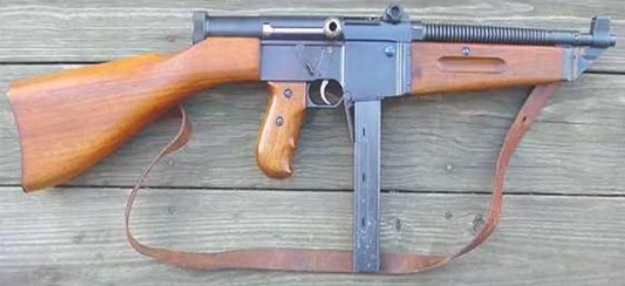
(The excellent but unlucky SIG design.)
As W+F had no pre-existing foundation to build off of, it relied on the social graces of Adolf Furrer to help close the gap. Furrer was well-connected in both Swiss political and military circles. He mounted what would be today called a “P.R. campaign” against the SIG gun, ridiculing the design’s weight, range, rate of fire, reliability, and (in his opinion) ugly appearance. At the same time he made grand promises that the W+F weapon would be technologically advanced, light, and easy to maintain.
None of Furrer’s insults against the SIG gun were really true. In hindsight, Furrer’s lobbying is all the more aggravating as his own design ended up being worse in all the categories he commented about.
As W+F’s design matured, it too was designated MP 41; based on the estimated in-service date. In 1940, a shoot-off was held between the two prototypes. The SIG weapon was essentially production-ready, while the W+F gun was a hand-assembled pre-prototype. Despite the SIG gun excelling in virtually all of the criteria, the Swiss army chose the W+F entrant, based on Furrer’s promises that it could be easily improved and (most importantly) be produced very fast. Both promises were untrue. In any case, the decision was final and SIG’s good design faded into history.
Basic description
The W+F MP 41/44 was 2’7″ long. The weight is an item of perspective; to win the contract Furrer gave an “issue weight” of 8 ¾ lbs; this was the bakelite version with no magazine inserted; this was barely lighter than the SIG gun’s weight including it’s magazine. W+F’s all-wood version with magazine weighed 11 ½ lbs and with the bayonet fitted, it topped 12 lbs; about as heavy as an infantry rifle.
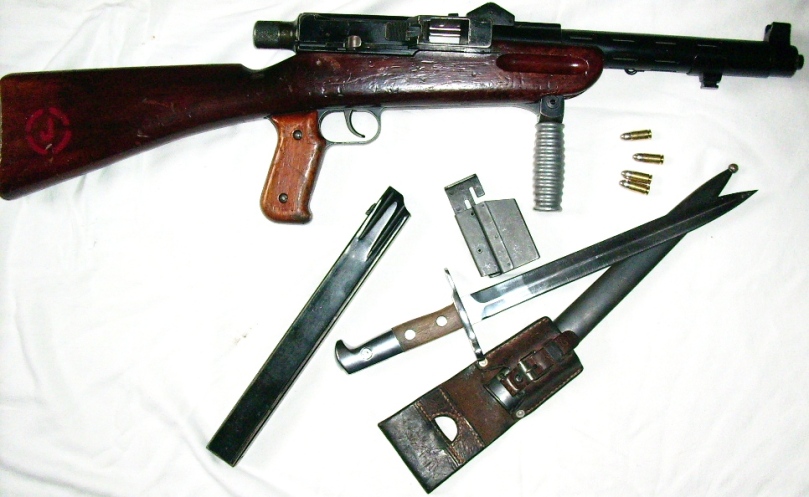
(A complete MP 41/44 loadout: gun, bayonet, scabbard, service tool, magazine, and 9mm rounds.) (photo from Forgotten Weapons website)
The MP 41/44 fired the worldwide-standard 9mm Parabellum cartridge from a double-stacked detachable 40-round box magazine. The magazine was inserted horizontal on the right side, opposite the ejection port on the left. The gun fired from the open bolt position and the rate of fire was 800rpm.
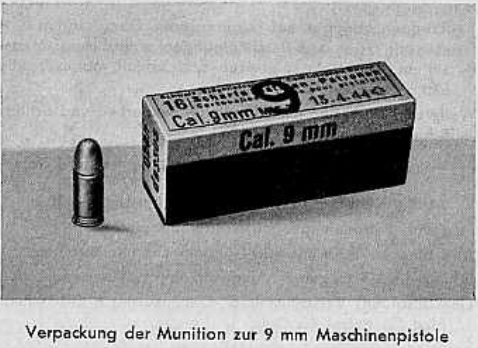
(Swiss army 9mm Parabellum ammunition in a 1944-stamped WWII box.)
The sights were basic, which was not much of an issue as the gun’s accurate range was listed as 200 yards but more realistically 75 yards in full-auto. A folding foregrip was fitted; it was held in position by an internal spring assembly. The barrel had a ventilated shroud, to which was welded the bayonet lug (another somewhat unusual feature in a submachine gun).
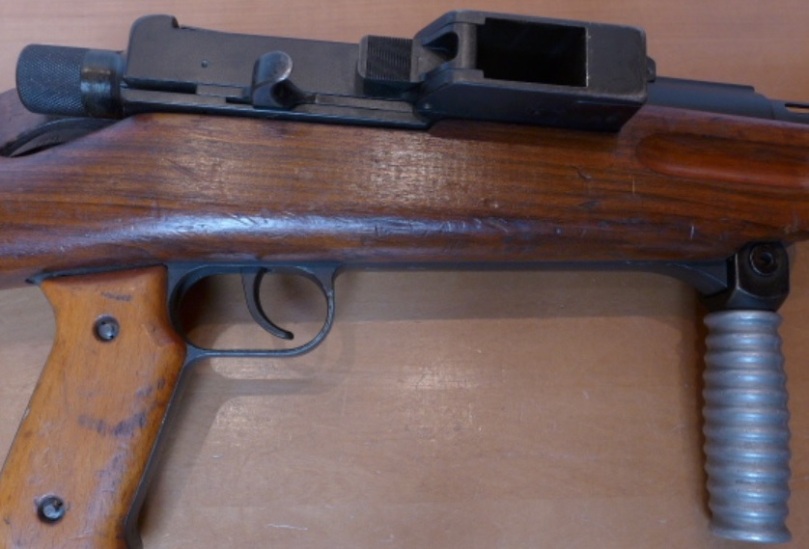
(Detail of the right side showing the magazine well with it’s release paddle, the folding foregrip, charging handle, and the knob over the rear spring.)
As designed, Furrer intended the weapon to have bakelite (plastic) furniture. It was one of the first guns in the world as such. The first 5,195 examples made had bakelite, which performed very poorly and cracked. The remainder switched to a mixture of wood and bakelite or more commonly, all wood. Almost all of the bakelite guns were later repaired with all-wooden stocks.
Soldiers fielding the MP 41/44 were issued a unique bandolier. It was two covered metal boxes, each box holding three loaded magazines. The boxes were spring-loaded so that the magazines wouldn’t rattle around, unfortunately this made quickly grabbing one difficult. The two-pack was affixed by a neck strap and two straps which attached to the soldier’s web belt. Like the MP 41/44 itself, it was way more complicated than need be.
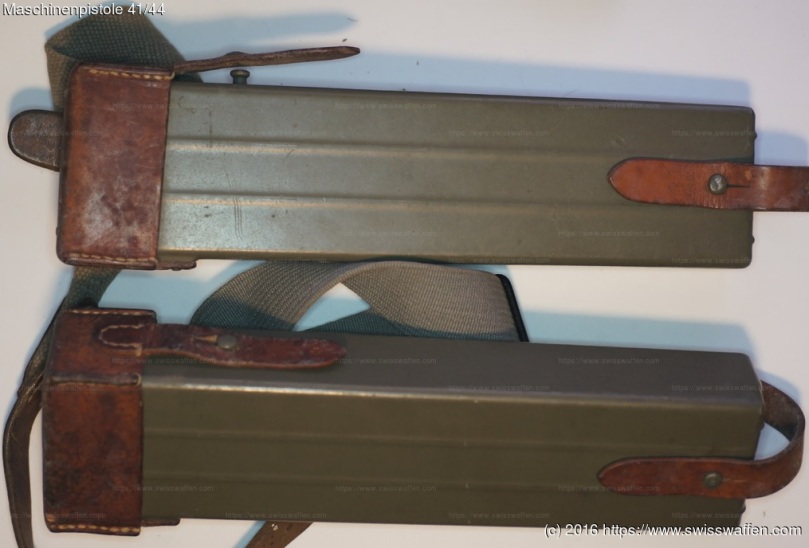
(The ammunition stowage rig for the MP 41/44.) (photo from swisswaffen.com website.)
the Furrer toggle-lock
The most interesting aspect of the MP 41/44 was it’s operating principle. Even by 21st century standards today, it was an incredibly complicated and over-engineered adaptation of the Maxim toggled recoil system. The action of the MP 41/44 was one of the most complex ever attempted in a production submachine gun.
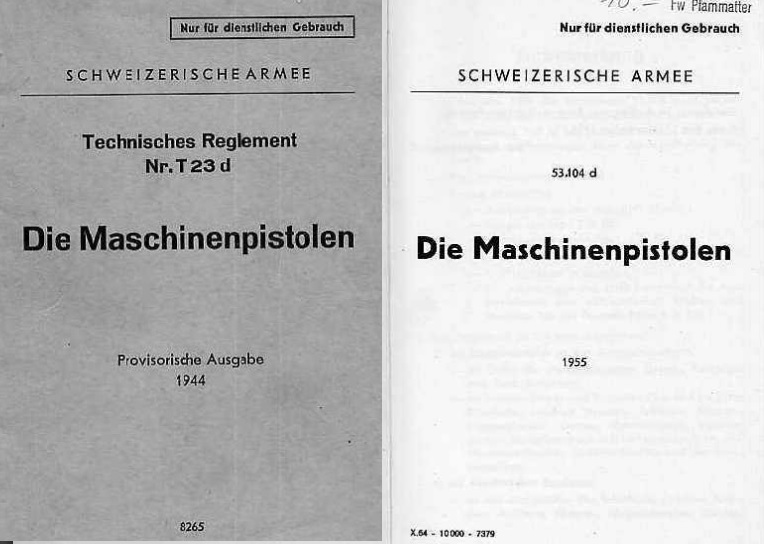
(Operator’s manual for the MP 41/44, with the WWII-era edition to the left and the Cold War-era edition to the right.)
Furrer was fascinated by the basic Maxim principle and foresaw it as the future of all firearms. He choose to further develop the concept. His toggle-lock system had been used on the Swiss army’s LMG25 machine gun, and Furrer planned on the Swiss army eventually using it on everything from anti-aircraft artillery down to pistols.

(Diagram of the Furrer toggle-lock in a MP 41/44. This diagram looks down on the top of the gun, with the muzzle end towards the left.)
In the MP 41/44, the barrel and bolt assembly were linked by a triple-jointed toggle which at rest, was straight. The toggle was set “sideways” in comparison to the gun overall. When fired, both the barrel and the bolt moved backwards a very short distance, upon which the toggle locked, bending like a human elbow. When bent the toggle was wider than the gun, so a covered opening on the left side of the receiver was fitted.
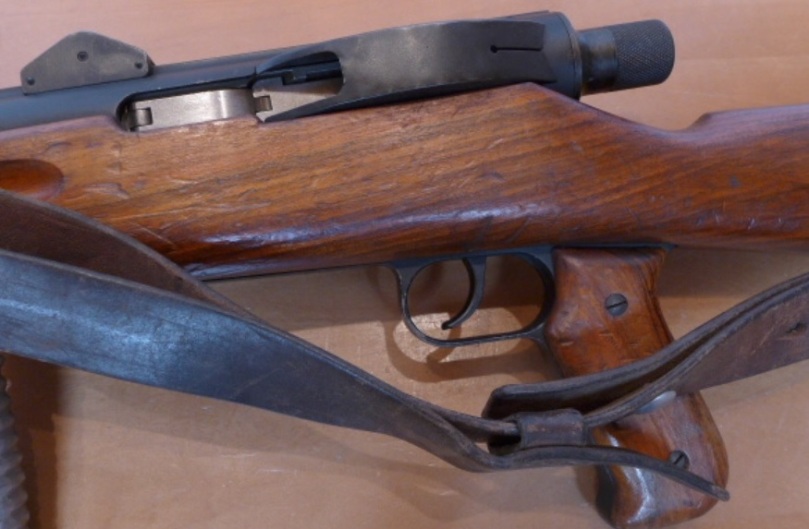
(Details of the left side of the MP 41/44, showing the breech’s ejection port (opposite the magazine on the weapon’s other side), the rear sight, and the curved protector for the toggle-lock to bend outwards inside of.)
Normally in recoil-principle firearms, at this point the barrel’s movement would end and the bolt would continue on it’s own to complete the ejection and extraction sequences as it returned to battery. With Furrer’s principle, the MP 41/44’s barrel and bolt assembly remained linked throughout the whole process. Naturally the bolt is moving backwards much faster than the barrel, and precise geometry in the angle of the bent toggle was needed to synchronize movement of the two. This was important as the spent casing had to be ejected out of the breech after the bolt assembly had moved, but before the barrel arrived. At the rear of the action was a heavy spring, it bounced the bolt assembly forward and essentially did the process in reverse, chambering a fresh round as the linked components passed the magazine receiver.
While, in the strictest sense of the word, Furrer’s system worked, there was absolutely no need for such a complex setup on a submachine gun. A comparable WWII weapon, the Soviet PPS-43, used a handful of cheap components in the blowback principle for far superior performance.
WWII use
Almost immediately after awarding W+F the contract, the Swiss army regretted their decision. The design was not finalized until the summer of 1941, when an initial batch of 50 guns was delivered. These were rejected and instead routed to legation guards of Switzerland’s embassy to France. As a neutral country, Switzerland observed the “armistice” between Germany and France and moved it’s embassy from Paris to Vichy, the self-styled capital of the puppet regime. This embassy was one of the busiest in the world, as besides Swiss affairs, it handled diplomacy for two dozen other nations which refused to recognize the puppet regime but none the less realized it existed.
Production finally started in the autumn of 1941, about half a year behind schedule. The MP 41/44 was incredibly expensive and time-consuming to make. Components of the toggle-lock had to be precision-manufactured, with tolerances in the <0.01″ range. Output was absurdly slow; by January 1942 (by which time any threat from Germany had passed) only 150 had been made. By 1 August 1943, the total was just 2,192, and by New Years Day 1944 just 2,749 guns.
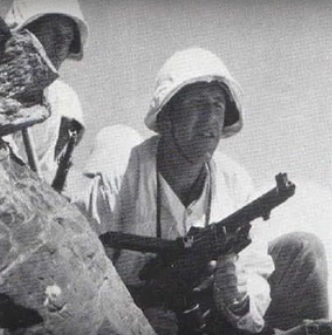
(A Swiss soldier with MP 41/44 in the Alps during WWII. The helmet is the Swiss stahlhelm M18. As a sidenote, the US Army briefly evaluated this helmet during the competition which eventually was won by the legendary M1 steel pot helmet.)
The design was beginning to show flaws in service. It was belatedly considered that putting the magazine on the right side was a mistake. Most soldiers are right-handed; and on most submachine guns with horizontal magazines, they are on the left so the soldier’s strong hand stays on the grip while the weak hand switches mags. With the MP 41/44, the soldier either had to set the gun down or change magazines upside-down. Swiss soldiers also commented that the bakelite furniture was cracking, and that the sights were about useless. Not surprisingly, soldiers were mortified at having to field-strip and reassemble it.
In June 1944, after the 5,200th weapon was delivered, the design was tweaked. The new version was designated MP 41/44 but since almost all the earlier production was later modified, today this is used for the weapon overall.
The changes were to add more robust protective wings to the front sight, a new rear sight adjustable out to 200 meters (218 yards), a modified bayonet lug, and a change from bakelite to wood for the furniture. Some effort was made to cut the production time; for example the cover over the toggle-lock opening was permanently welded on instead of being riveted, and the wrapped canvas cover for the foregrip was cancelled.

(This is possibly a factory-overhauled MP 41/44 of the early production lot as it has all of the final features but still has the fabric covering to the foregrip.) (photo from guns.ru website)
It was considered to invert the magazine well / ejection port from right to left, but this would have required redesigning the toggle-lock mechanism and by this point the Swiss didn’t dare mess with that component any more.
By this time, nearly half a decade had passed since the initial requirement was issued, and the Swiss army was clamoring for new submachine guns, right away. As a stop-gap, a license was bought from Finland for the Suomi m/31 which was made by Hispano-Suiza as the MP 43/44. Production of the “substitute” MP 43/44 eventually exceeded that of the MP 41/44 and it was more popular in service.

(The MP 43/44 submachine gun, the ‘Swiss Suomi’.)
WWII in Europe ended in May 1945, with Switzerland successfully having stayed neutral and the MP 41/44 seeing no combat. Later that year, production ended at approximately the 9,700th gun (there are small gaps in the serial numbers because of assembly failures).
After WWII
There was no question that the post-WWII Swiss army would be stuck with the MP 41/44. Adjusting both the Swiss Franc and US Dollar for inflation, each individual gun cost $5,251 in 2016 dollars. The project overall cost in excess of $51.9 million in today’s money, an astonishing sum for a small country like Switzerland to spend on what should have been an inexpensive thing. While the victorious Allies were scrapping wartime guns that were unsatisfactory, for certain the Swiss government was not going to allow their army to simply throw an expense like this into the trash.
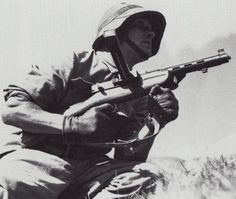
(Early Cold War-era Swiss soldier with a MP 41/44. The stahlhelm M18 remained in use until 1971.)
New problems were being created by the MP 41/44. During it’s early trials, the measured muzzle velocity was 1,295fps, below the SIG competitor. There were problems with using generic 9mm Parabellum rounds, in that they sometimes did not create enough recoil to effectively work the toggle-lock system. It was suggested to tweak the propellant load of Swiss military-issue 9mm Parabellum rounds, this resulted in a satisfactory 1,313fps from the MP 41/44. However it naturally led to safety concerns for pistol use; obviously there was no realistic way two “streams” of identical ammo could be maintained for MP 41/44 users and everybody else. The international organization SAAMI recommends gun designers test weapons at 30% above the expected chamber pressure, but for decades after WWII the Swiss army proofed 9mm handguns at 50% above because of the “poisoned” 9mm stockpile.

(Cold War-era Swiss army 9mm Parabellum packaging.)
The Swiss army tried to rectify some issues with new operational guidelines; sometimes with unintentionally humorous results. For example, it suggested making adjustments to the spring if the gun was repeatedly fired on an incline, such as from a mountain into a valley. Obviously there was no way soldiers could realistically do this in the event of a real war.
Efforts to get a MP 41/44 replacement were stymied by a brief diplomatic spat with the USA in 1945. After Germany’s surrender the three western Allies began seizing assets and patents of German industry. Since the 1920s, companies in neutral Switzerland had been intertwined with German firms across the border. As Switzerland was one of the few European countries to remain neutral before, during, and after WWII, it did not agree to the American demand to unwind Third Reich-era contracts and for a brief while, the USA was preparing a “black list” of Swiss companies and banks to embargo. The net effect was a hesitancy in the Swiss credit market which discouraged new government spending. The issue eventually blew over with no consequence in 1946.
One of the guns designed during this time was SIG’s MP 46. A good design, this proposed MP 41/44 replacement had nice features including a novel revolving drum-style rear sight. Because of the credit crunch no Swiss army order was forthcoming and the project was cancelled. It was later refined into the export-only MP 48 for Chile, but in Switzerland the MP 41/44 continued in use.

(The prototype SIG MP 46 which failed to reach mass production.)
Still in use during the Cold War, the MP 41/44s were reassigned to festungwachtkorps (fortress troops); Swiss infantry tasked with manning the many bunkers and strongpoints throughout the country. An issue identified in the MP 41/44’s general infantry use had been dirt fouling the precise tolerances between the toggle-lock components. It was hoped that if used by soldiers in a primarily indoors environment, this might be lessened.

(This ‘civilian house’ in Switzerland is actually a cleverly-disguised Cold War concrete bunker. The entire second story and roof are a wooden dummy. The loose lumber and pallet conceals firing points, while the door and window are a wooden false front.)
Any plan to self-fund a replacement by selling the MP 41/44s abroad was limited by the gun’s terrible reputation. At the same time, financing a replacement with exports of a new design in the early 1950s was nearly impossible, thanks to the huge number of WWII-surplus Stens and M3 Grease Guns floating around.
In 1957, the SIG StGw 57 assault rifle entered Swiss army use as the standard infantry longarm; somewhat filling the full-auto niche that submachine guns had held when semi-auto and bolt-action rifles were in use. The MP 41/44 was withdrawn from active-duty use in 1959-1960, thereafter being put into warehouse storage. In 1970, they were declared obsolete. There were two large scrap melts; one in 1971 and another in 1974, when the entire remaining stockpile plus all spare parts were destroyed.
Around 400 MP 41/44s were not scrapped, either for museum donation or licensed sale abroad. These guns are extremely rare today. In 2006, one operational NFA-transferable example in the USA sold for $52,000. Today in 2016 even deactivated museum weapons typically sell in excess of $10,000.
The entire MP 41/44 episode is regarded in Switzerland as their military’s biggest boondoggle and the gun is not fondly remembered there.

Reblogged this on Rifleman III Journal.
LikeLike